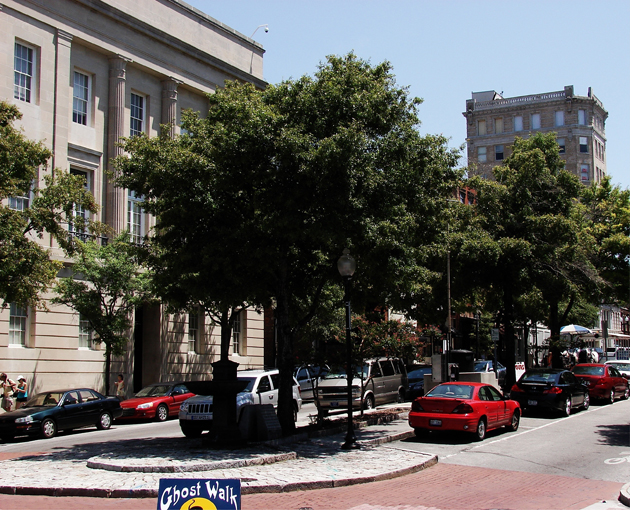Publisher's note: We believe the subject of history makes people (i.e., American people) smarter, so in our quest to educate others, we will provide excerpts from the North Carolina History Project, an online publication of the John Locke Foundation. This seventy-sixth installment, by William K. Bolt, University of Tennessee, was originally posted in the North Carolina History Project.
Commercial restrictions through tariffs have been an integral part of American history. The federal government has used forms of commercial restriction as a source of revenue and to protect American industry and labor. Before the Civil War, the federal government obtained close to ninety percent of its revenue from tariffs, and because of this, the government avoided income taxation.
Americans have used protective and revenue tariffs. Protective tariffs help new American industries compete with established foreign industries. Proponents of protective tariffs claim that all segments of America benefit from tariffs. Foes of protective tariffs argue that protective tariffs help a few interests at the expense of many. By barring foreign goods from American markets, American manufacturers can charge whatever price they want for their goods and force American consumers to pay exorbitant prices. Conversely, revenue tariffs are used to provide the government with revenue and offer only incidental protection to industries.
The Articles of Confederation did not grant Congress the power to enact tariffs. In the spring of 1781, with the outcome of the Revolution undecided and the nation heavily in debt, Congress asked the thirteen states for the power to levy an impost. North Carolina was among the first states to grant Congress the power because Tar Heels preferred an impost to a tax on land. Furthermore, North Carolina had few ports from which they could collect duties on imports. Despite the efforts of its supporters, the impost never became law.
Some scholars have suggested that the Founding Fathers replaced the Articles with the Constitution of 1787 because of the commercial flaws of the Articles. In the new federal constitution, Congress obtained the power "to lay and collect taxes, duties, imposts, and excises." One of the first pieces of legislation that the first Congress passed was the tariff of 1789. Most imported goods received a duty of only five percent ad valorem (in proportion to the value) under this tariff.
The Republican Party of Thomas Jefferson showed little interest in the tariff. During the War of 1812, the British navy prevented goods from coming to American shores. As a result, Americans manufactured their own products. To protect infant manufacturers, Congress passed the nation's first protective tariff: the tariff of 1816. Average duties stood at around twenty-five percent ad valorem. Every North Carolina Congressmen voted against this measure.
Congress attempted to raise tariff levels with the Baldwin Tariff of 1820 but failed by a single vote in the Senate. Lemuel Sawyer was the only Tar Heel to support this tariff in Congress. In 1824, Speaker of the House Henry Clay argued that a protective tariff would increase the national wealth. It would also create a home market where agricultural prices and wages increased. P. P. Barbour first argued that a protective tariff was unconstitutional. The bill passed by only five votes in the House and four in the Senate. The distribution of the vote revealed that the tariff had become a sectional issue. Every North Carolina Congressmen opposed the tariff in 1824. Importers now paid duties of about thirty-five percent ad valorem.
Some manufacturing interests claimed that the tariff of 1824 did not offer them enough protection. They successfully passed the tariff of 1828, which southerners branded as the "tariff of abominations." Once again, every North Carolina Congressmen disproved of a tariff bill. Average import rates now stood close to fifty percent.
Opponents of the tariff in South Carolina nullified this tariff and the subsequent tariff of 1833, which lowered average duties to about thirty three percent ad valorem. President Andrew Jackson equated nullification with treason and talked of hanging his own vice president, John C. Calhoun, whom he held responsible for the crisis over the tariff. At the end of 1832, Calhoun resigned the vice presidency and returned to Washington, D. C. as a Senator. There, he helped pass a compromise tariff that gradually lowered duties over the span of ten years with the sharpest cuts coming after 1840. Every North Carolina Congressmen endorsed the compromise tariff.
Few in North Carolina supported the doctrine of nullification but most agreed with South Carolina over the unconstitutionality of a tariff. The state legislature concurred with Jackson and called nullification a "revolutionary" and "subversive" doctrine. Some of the leading proponents of states' rights in the state such as Willie P. Mangum, however, broke with Jackson over his handling of the crisis.
The accord of 1833 lasted until 1842. President John Tyler vetoed several tariff bills so protectionists called his impeachment and tried to change the rules to provide that only a majority was required to override a presidential veto. With a nearly bankrupt treasury, Tyler finally approved the tariff of 1842, which restored many of the levels of the tariff of 1832. Every North Carolinian in Congress, regardless of party, opposed this tariff.
 The United States Courthouse and United States Customs House along the the waterfront of the Cape Fear River in Wilmington, NC is now the Alton Lennon Federal Office Building. At one time tariffs were collected here in North Carolina's busiest port - Wilmington. View of the southern side of the Federal Customs House along Market Street: Above.
Front view of the Federal Customs House along the Cape Fear: Below. photos by Stan Deatherage Click images to enlarge.
The United States Courthouse and United States Customs House along the the waterfront of the Cape Fear River in Wilmington, NC is now the Alton Lennon Federal Office Building. At one time tariffs were collected here in North Carolina's busiest port - Wilmington. View of the southern side of the Federal Customs House along Market Street: Above.
Front view of the Federal Customs House along the Cape Fear: Below. photos by Stan Deatherage Click images to enlarge.

James K. Polk, who had been born in the Old North State and graduated from the University of North Carolina, entered the Executive Mansion with a commitment to lowering the tariff. The Walker tariff slashed duties to about twenty percent ad valorem. The vote on the Walker tariff divided North Carolina Congressmen along partisan lines. The four Whigs opposed the measure while the six Democrats supported it. Advocates of high tariffs claimed that the Walker tariff would ruin the country, but its low duties on iron actually allowed for the railroad boom of the 1850s. Congress then lowered most of the duties of the Walker with the tariff of 1857.
The Panic of 1857 resurrected the tariff debate. The Republicans needed an issue other than the opposition to the extension of slavery, and Republican leaders seized on the protective tariff. Justin S. Morrill proposed a tariff bill in 1860, which passed the House but stalled in the Senate. After the first Southern states seceded, little opposition to the tariff remained in the Senate and the Morrill tariff passed with ease. North Carolina Congressmen opposed the measure at every step.
Sources:
Alfred Eckes, Opening America's Market: U.S. Foreign Trade Policy Since 1776 (Chapel Hill, 1995); Richard E. Ellis, The Union at Risk: Jacksonian Democracy, States' Rights, and the Nullification Crisis (New York, 1987); Eric Foner, Free Soil Free Labor, Free Men: The Ideology of the Republican Party Before the Civil War (New York, 1970); William W. Freehling, Prelude to Civil War: The Nullification Controversy in South Carolina, 1816-1836 (New York, 1965); Richard Hofstadter, "The Tariff Issue on the Eve of the Civil War," American Historical Review, XLIV (October, 1938); James L. Huston, The Panic of 1857 and the Coming of the Civil War (Baton Rouge, 1987); H. Paul Jeffers, An Honest President: The Life and Presidencies of Grover Cleveland (New York, 2000); William E. Leuchtenburg, Franklin D. Roosevelt and the New Deal, 1932-1940 (New York, 1963); Jackson T. Main, The Antifederalists: Critics of the Constitution, 1781-1788 (Chapel Hill, 1961); H. Wayne Morgan, William McKinley and His America (Kent, 2003); Phillip Shaw Paludan, A People's Contest: The Union and Civil War, 1861-1865 (Lawrence, 1988); Jonathan J. Pincus, Pressure Groups and Politics in Antebellum Tariffs (New York, 1977); Joanne Reitano, The Tariff Question in the Gilded Age: The Great Debate of 1888 (University Park, PA, 1994); Robert V. Remini, Henry Clay: Statesman for the Union (New York, 1991), Martin Van Buren and the Making of the Democratic Party (New York, 1951); Robert Seager II, And Tyler Too: A Biography of John and Julia Gardiner Tyler (New York, 1963); Edward Stanwood, American Tariff Controversies in the Nineteenth Century. Vol. 1 of 2. (Boston, 1903); Robert F. Wesser, "Election of 1888," Arthur M. Schlesinger (ed.), History of American Presidential Elections. Vol. 4 of 4. (New York, 1971); Paul Wolman, Most Favored Nation: The Republican Revisionists and US Tariff Policy, 1897-1912 (Chapel Hill, 1992); William Frank Zornow, "North Carolina State Tariff Policies, 1775-1789," North Carolina Historical Review, XXXII (April, 1955).
























